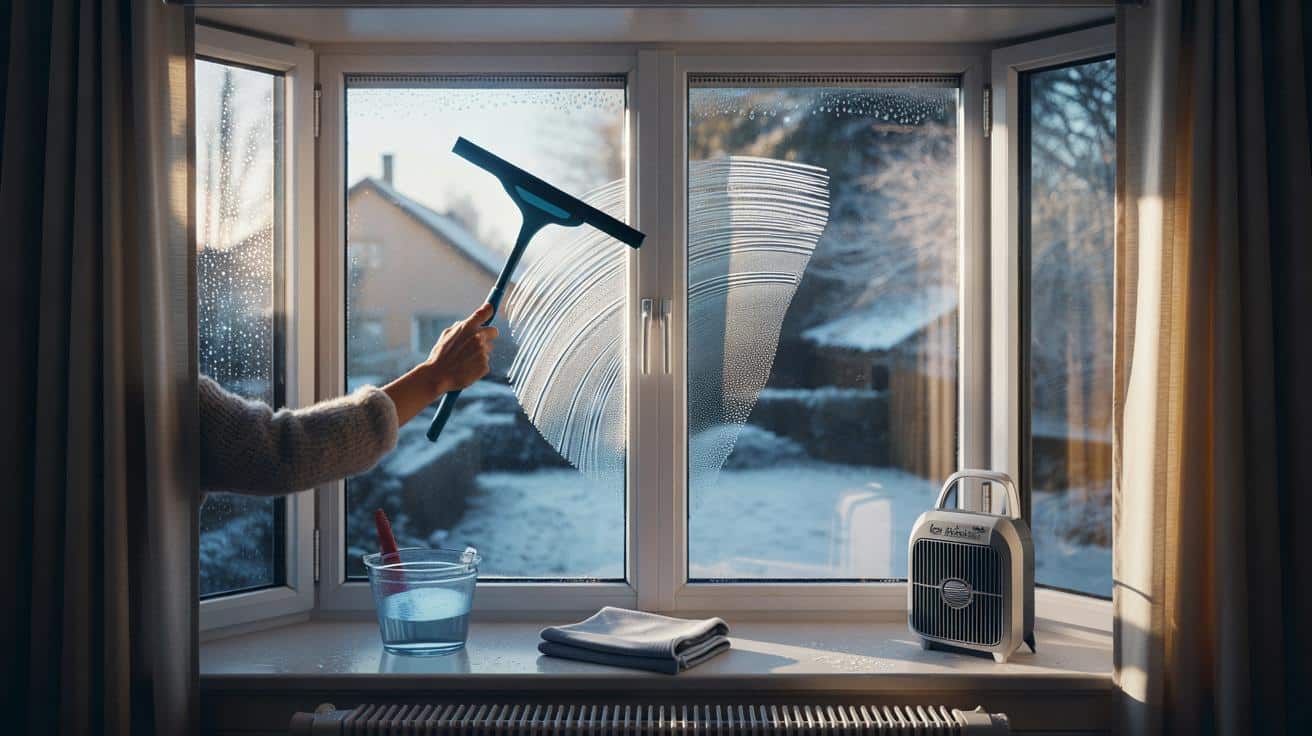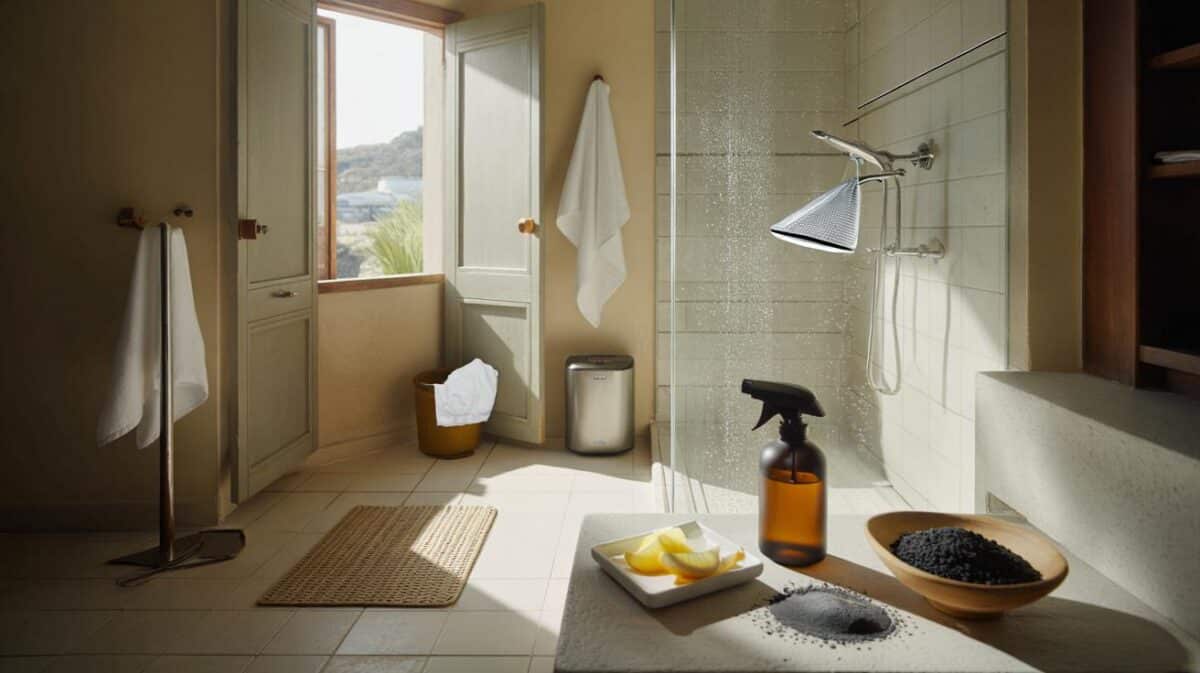It shows dust, damp breath and last night’s cooking on every pane within minutes.
Most households wage a quiet battle with misted glass and grey smears from November to March. The fix doesn’t need heroics. It needs order, kinder mixtures and small daily habits that stop vapour turning to water on the coldest surface in the room.
What makes winter glass smear and fog
Cold glass changes how cleaning works. Warm suds flash-dry on a chilly pane and leave a faint film of detergent and minerals. Low sun then spotlights every trail. Dirty frames add to the mess: chalky uPVC, dust and grime jump from the edges onto the glass as soon as you start wiping.
Condensation plays a different game. Indoor air holds moisture from showers, kettles and laundry. When that air cools to its dew point, it dumps liquid on the thinnest, coldest surface: the window. Small flats often peak above 65–70% relative humidity in the evening, so mist forms fast and returns after lunch when the sun hits.
Beat both problems by changing sequence, mix and temperature: clean frames first, use cool water with minimal soap, and keep rooms steady at 18–19°C with regular, short ventilation.
From frames to panes: the pro order that stops streaks
Clean the frames first
Vacuum the tracks and weep holes with a soft brush. Wipe uPVC with warm water and a pea-sized dot of washing-up liquid on a microfibre. For timber, use barely damp, pH‑neutral soap, then dry the wood straight away. Aluminium needs the same gentle approach. Finish by buffing frames dry so residue won’t leap to the glass.
Mix that works in the cold
Fill a small bucket with cool water and a single drop of washing-up liquid. Add a splash of distilled or deionised water to cut mineral marks. On near-freezing days, include a capful of isopropyl alcohol so the solution doesn’t glaze before your first pass. A fingertip of dishwasher rinse aid helps water sheet rather than bead.
Technique that leaves no marks
Soak the pane, then squeegee in relaxed S‑strokes. Wipe the rubber after every pass. Detail the edges with a dry microfibre. Replace nicked or tired squeegee rubbers; dull blades draw lines, however carefully you move. Skip paper towels, direct sunlight and heavy suds – they leave lint, lock in streaks and create film that blooms under low sun.
- Core kit: 30–35cm squeegee, two microfibres (one damp, one dry), soft brush, small bucket, distilled water.
- Handy extras: isopropyl alcohol for freeze days, a plastic scraper for paint flecks, a window vac for morning droplets.
- Things to avoid: cream cleansers on glass, strong solvents on uPVC, modern newspaper inks on any frame.
Frames first. Cool water with a tiny soap dose. Fresh rubber. Edges last. That rhythm delivers the clean you see on pro jobs.
Fighting condensation before it forms
Think routine, not rescue. Open trickle vents. Give rooms a five‑minute burst of fresh air morning and night. Cook with lids on and keep the extractor running for a little longer than feels necessary. Let bathroom fans run until the mirror clears. Dry laundry in one closed room with a dehumidifier if possible. Aim for 40–55% relative humidity and keep living spaces steady at 18–19°C so glass doesn’t plunge cold after dark.
Help the window itself. Leave a slim gap behind curtains or blinds so air can sweep the pane. Check and clear frame weep holes; water trapped in the channels re‑wets the bottom edge. On bathroom glass, buff a faint film of washing‑up liquid until it “disappears”; it slows fogging for a few days. Use shaving foam only on mirrors, and keep it away from seals.
| Room | Action (5–10 minutes) | Expected effect |
|---|---|---|
| Kitchen | Lids on pans, extractor on 10 minutes after cooking | Lower evening humidity spikes by 10–15 percentage points |
| Bathroom | Fan on until mirror clears, door ajar after showers | Faster vapour removal, less water on nearby windows |
| Bedroom | Crack trickle vent overnight, short morning vent | Drier sills, fewer droplets at the bottom edge |
| Laundry room | Dehumidifier while drying, door closed | Containment of moisture load, warmer-feeling rooms |
Short bursts of fresh air beat permanently open windows: you dump moisture without draining heat from the fabric of the home.
Troubleshooting: when the glass still weeps every morning
Remove water fast so it can’t feed mould. Use a window vac or a dedicated microfibre, starting at the bottom edge where droplets pool. Move furniture a hand’s breadth off cold outside walls to prevent chill spots. Don’t drape curtains over radiators beneath windows; you want warm air flowing up the glass. If you live with single glazing, fit a clear seasonal film kit for the winter months – it raises inner surface temperature enough to slow dew.
Black marks on seals need careful treatment. Use a dilute bleach solution or a specialist mould remover, rinse, and dry the area. Keep humidity in check afterwards so it doesn’t return. If vinegar helps with greasy film on glass, keep it away from uPVC and stone sills; it can dull or react with finishes. Always rinse if it strays.
Cold‑season tactics that save time and money
Want a quick check on your risk? If your room sits at 19°C with 60% relative humidity, the dew point sits around the low teens. Any pane that falls below that will mist. Lower the humidity to 45% and you gain several degrees of safety before vapour turns to water. A £10 hygrometer gives you the numbers you need to judge when to vent or dehumidify.
Running costs worry many households, so here’s a simple yardstick. A small dehumidifier rated at 150W, used four hours a day, consumes about 0.6kWh. At 28p per kWh, that’s roughly 17p per day, or about £1.20 per week. In return, you get drier rooms, faster‑drying laundry and fewer mould risks. Most units include a timer; set it for the dampest hours rather than all day.
Quick wins you can try today
- Test your squeegee rubber on a mirror: if it leaves lines, flip or replace the blade before tackling big panes.
- Switch your final rinse to distilled or deionised water if you live in a hard‑water area; it removes mineral ghosts that appear at noon.
- Edge‑detail with a clean, dry microfibre only; a damp cloth drags residue back onto the border.
- Keep a “condensation cloth” or window vac by the coldest window so you deal with droplets in under a minute each morning.
A steady 18–19°C with brief ventilation beats big peaks and dips. Warm the glass a little, dry the air a little, and fog stops forming.
Extra context for readers who want to go further
Think about the building’s fabric. Trickle vents often clog; a two‑minute clean can restore airflow that prevents overnight mist. Old trickle vents without draught control may make rooms feel chilly; newer clip‑style vents temper flow while still removing vapour. If you own the property, secondary glazing or magnetic acrylic panels create a winter air gap that lifts inner glass temperature and cuts traffic noise while you’re at it.
For renters or small spaces, a rotation plan helps: treat bathrooms and kitchens weekly, bedrooms fortnightly, and living areas every four to six weeks. Keep a tiny “window kit” – squeegee, two cloths, travel bottle of mix – under the sink. The job then drops under ten minutes for a whole flat. Pair that with a “steam budget” in the evening: lids on pots, fan on, door closed while drying clothes. Small gains stack up to a clear view and drier mornings.








